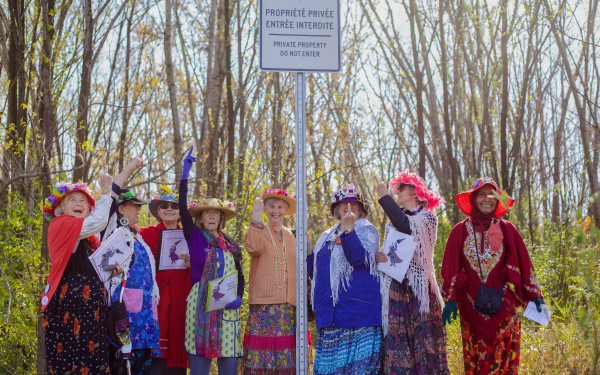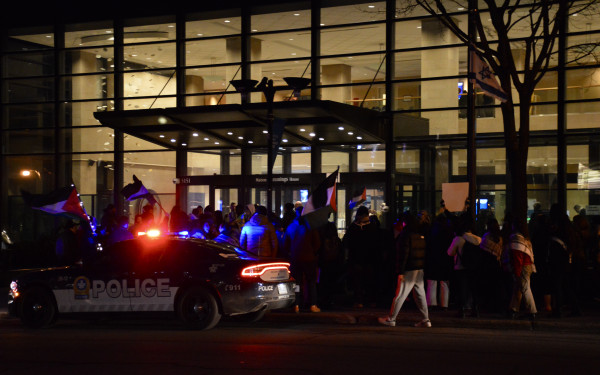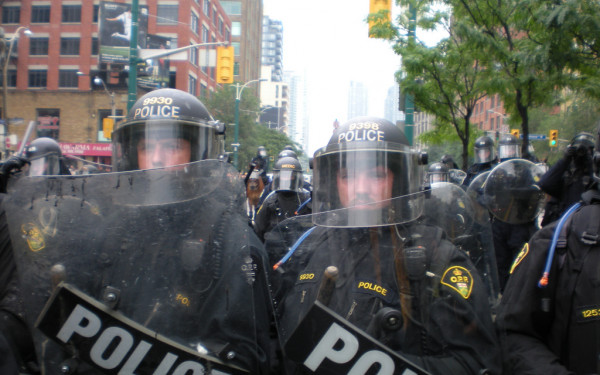Idling Once More
Rail Blockades Stall Travellers as Harper’s Meeting With First Nations Chiefs Approaches
For the second time in less than a week, a trackside Idle No More protest closed down the most popular commercial rail line in the country.
The demonstration, which started around 5:00 p.m. Saturday evening, halted all traffic on the Montreal-Toronto train corridor just east of Belleview Station.
Members from the surrounding Tyendinaga Mohawk community, in conjunction with the growing Idle No More movement, joined the protest.
The movement aims to protect land and water treaty rights proponents say are being threatened, as well as advocate for other indigenous people’s issues.
A meeting between Canadian Prime Minister Stephen Harper and chiefs from the Assembly of First Nations is scheduled for this Friday—and Tyendinaga protesters say the native leadership needs leverage.
“We’re here to show the First Nations leadership and the government of this country that our leaders can go to the table next week in a position of power instead of a position of pity, and knowing they have the people backing them,” said Tyendinaga protester Dan Doreen to the Aboriginal Peoples Television Network.
“We can shut the goods down east to west, north to south.”
Four VIA trains were stopped en route until past midnight Sunday morning.
According to VIA Rail spokesperson Jacques Gagnon, around 1,000 customers were affected by the stoppage, though that number could have ballooned to over 8,000 if the blockade had continued throughout the weekend.
“Sundays are very busy travel days during the holiday season,” explained Gagnon, with people returning to work or studies in greater numbers “at the last minute.”
At least 2,500 travellers were delayed during the previous stoppage, which occurred Dec. 30, though that blockade lasted for two fewer hours than the demonstration this Sunday.
Gagnon said VIA personnel were more prepared this time around, with the Ontario Provincial Police informing them beforehand of the possibility of a protest.
Passengers left stranded trackside around Ontario and Montreal were redirected to chartered buses to get around the blockade.
This was in contrast to last Saturday, when buses only arrived after three and a half hours and weren’t ultimately used—travellers were advised just before boarding that the tracks had finally been cleared.
However, passengers had to wait almost another hour before embarking once more.
During the blockade, information was sparse—both to passengers and internally to VIA personnel.
According to a VIA train supervisor wishing only to be identified as Luke, emails explaining the situation to personnel only arrived at 6:50 p.m.—ten minutes before the blockade was originally slated to end.
Sarnia Blockade
The Montreal-Toronto train corridor was not the only railway blocked, as Idle No More and its tactics continued to grow.
In Sarnia, ON, a 13-day ordeal only ended last Wednesday after the Canadian National Railway Company filed multiple court injunctions to remove the blockade.
Other transport arteries have been blocked, including border crossings in Sarnia and Cornwall, ON.
CN Rail also owns the tracks between Montreal and Toronto used commercially by VIA Rail.
According to CN spokesperson Jim Feeny, both blockades near Belleview Station triggered sensors on rail crossing signal devices.
Tampering with signal devices is a federal offence, Feeny said, and trains cannot legally run while the alarm is raised.
“CN will seek to prosecute anyone who tampered with the signal,” he added.
But according to reports from APTN and Tyendinaga Mohawk Chief R. Donald Maracle, the protests were never on track lines to begin with.
The exact location of signal devices in reference to train tracks could not be divulged “for national security reasons,” said Feeny—but he says VIA personnel did see demonstrators on the tracks.
“We’re here to show the First Nations leadership and the government of this country that our leaders can go to the table next week in a position of power instead of a position of pity, and knowing they have the people backing them. We can shut the goods down east to west, north to south.”
—Dan Doreen, Tyendinaga Protester
Chugging Forward
Though the train blockade ended on Sunday, proponents of the Idle No More movement say they will continue demonstrations as a meeting between Harper and First Nations leaders is set for this Friday.
Attawapiskat Chief Theresa Spence, who has been on a hunger strike since Dec. 11 in support of the grassroots movement, says she plans to attend.
She began her campaign for a meeting with the prime minister and a representative of the Crown to discuss treaty rights on water and reserve land as well as poverty, loss of reserve funding and other indigenous issues.
“There are a lot of issues that have to be talked about: the right to education, the right to tax immunity, the right to health care and to have a proper and fair share of the resource well in this country, which fuels the entire Canadian economy,” said Maracle.
The major concern from the evolving Idle No More movement is the omnibus Bill C-45 implemented last month by the Conservative government, which dissenters argue makes it easier for reserve land to be exploited for its natural resources.
After weeks of dismissing calls to meet with Spence and other First Nations leaders, Harper announced on Friday that he would meet with the AFN.
Though dialogue is a good sign, Idle No More supporter and originator of the Twitter hashtag #idlenomore Tanya Kappo says she isn’t expecting much progress.
“I hate to seem like such a cynic,” said Kappo, “and looking ahead to Friday I don’t see anything different at all [resulting from the meeting].”
“I’m not aware at this time of any ‘grassroots’ people getting invited to meeting,” said Tanya Kappo. “Even the statement that the prime minister made in announcing the meeting made no mention of Chief Spence or Idle No More.”
Idle No More Timeline
Late October: Jessica Gordon, Sheelah McLean, Sylvia McAdams and Nina Wilsonfeld begin discussing concerns with Bill C-45 via email. They deem the legislation detrimental to indigenous land and water rights.
Nov. 10, 2012: Styled as a teach-in, the first Idle No More meeting is organized by Gordon, McLean, McAdams and Wilsonfeld in Saskatoon. Similar events pop up in Regina, Winnipeg and Prince Albert, SK in the following days.
Dec. 2, 2012: “#idlenomore” enters the social media lexicon after first being used by movement organizer Tanya Kappo.
Dec. 6, 2012: During a second reading of Bill C-45, Assembly of First Nations chiefs attempt to enter the House of Commons in protest. Proposed amendments to the bill, put forth by the New Democratic Party opposition, are blocked by the Conservative majority.
Dec. 10, 2012: Billed as a national day of action, thousands of Idle No More supporters take to the streets in a slew of cities across Canada. Attawapiskat Chief Theresa Spence announces her hunger strike.
Dec. 11, 2012: Spence begins a liquids-only hunger strike to pressure Prime Minister Stephen Harper, Crown representatives and other First Nations chiefs to discuss economic development for reserves.
Dec. 17, 2012: Canadian National Railway Company lines in Sarnia, ON are blocked by Idle No More protesters. The occupation lasts 13 days, eventually removed after CN Rail files two injunctions against protest spokesperson Ron Plain for contempt for not having disbanded the blockade.
Dec. 30, 2012: Protesters from the Tyendinaga Mohawk reserve halt trains along the Montreal-Ottawa-Toronto corridor for over four hours, with trackside banners calling for solidarity with Spence and her campaign to meet the prime minister.
Leaders of Idle No More issue an online statement distancing the movement from band council chiefs, saying the movement has “a clear mandate […] to work outside of the systems of government and that is what we will continue to do.”
Jan. 4, 2013: Harper agrees to meet with First Nations leaders. Spence says she intends to attend, but will continue her hunger strike until then.
Jan. 5, 2013: Supporters block several border crossings, including the Seaway International Bridge in Cornwall, ON and a crossing in Sarnia.
Another train blockade is set up outside Belleville, ON—this marks the second stoppage on the line in a week.
Jan. 6, 2013: The Quebec arm of Idle No More organizes the first teach-in in the province.
January 8, 2013: Spence says she will not be attending the meeting with Harper on Jan. 11, after Governor General David Johnston’s office releases a statement that Johnston will not be at the meeting due to a schedule conflict. Spence insists Johnston’s presence is integral to discuss treaty issues.
January 9, 2013: A press conference expected to be held Wednesday by the Assembly of First Nations National Chief Shawn Atleo is pushed to the afternoon of Jan. 10.
Jan. 10, 2013: Johnston’s attendance at Friday’s meeting is confirmed by a statement issued by the Rideau House Press Office and The Prime Minister’s Office.
Jan. 11, 2013: A delegations of chiefs from the AFN meet with PM Harper and Governor General David Johnston—though the Queen’s representative only comes for the ceremonial parts. AFN chiefs are split on the impact of the meeting, with some such as Manitoba Grand Chief Derek Nepinak boycotting the working meeting.
Meanwhile, in the streets across Canada, thousands keep the pressure on the government and the AFN delegation to address the growing concerns of First Nations peoples and supporters of the Idle No More movement.
Jan. 12, 2013: The Quebec Grand Chief of the Grand Council of the Crees calls on Chief Spence to cease her hunger strike. “I’m not sure who is advising her,” he told CBC, speaking of her belief of the Governor General being able to act for the Crown and supersede the current government.
Jan. 13, 2013: Leader of the NDP Thomas Mulcair tells CTV he wants Chief Spence to end her hunger strike. “I would sincerely call upon Chief Spence to realize […] the government seems to be moving so I think that the best thing to do would be to step back from that now,” said the leader of the Opposition.
Jan. 14, 2013: Road and border crossing blockades are expected on Wednesday, Jan. 16, according to statements from First Nation chiefs and Idle No More supporters. Another national day of action is planned for Jan. 28.

2_900_600_90.jpg)
_600_832_s.png)




